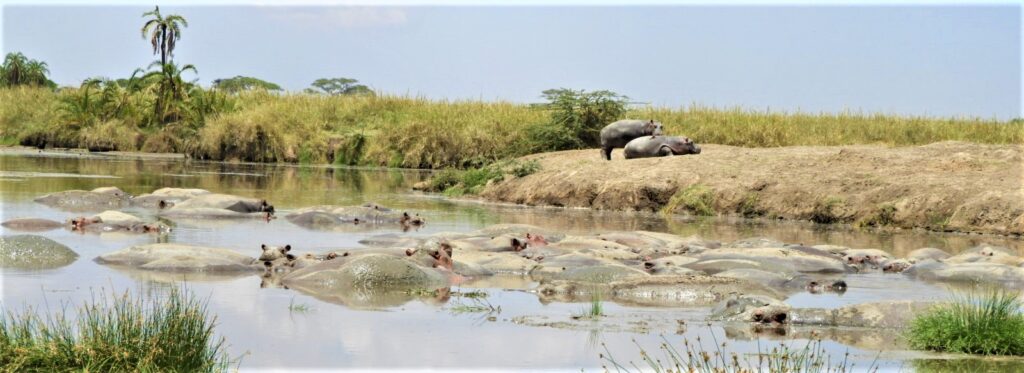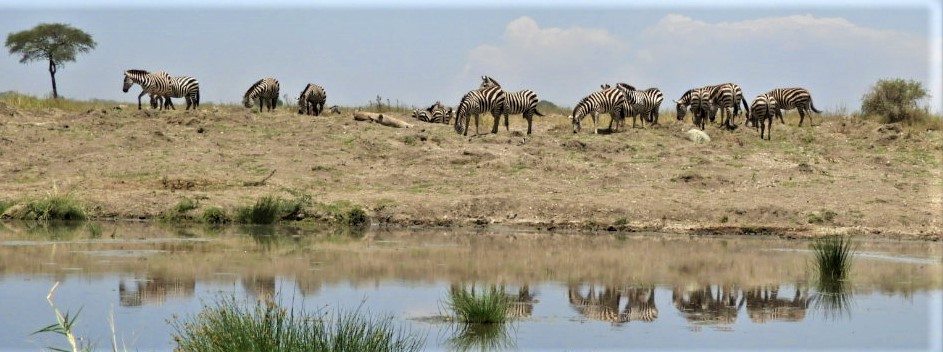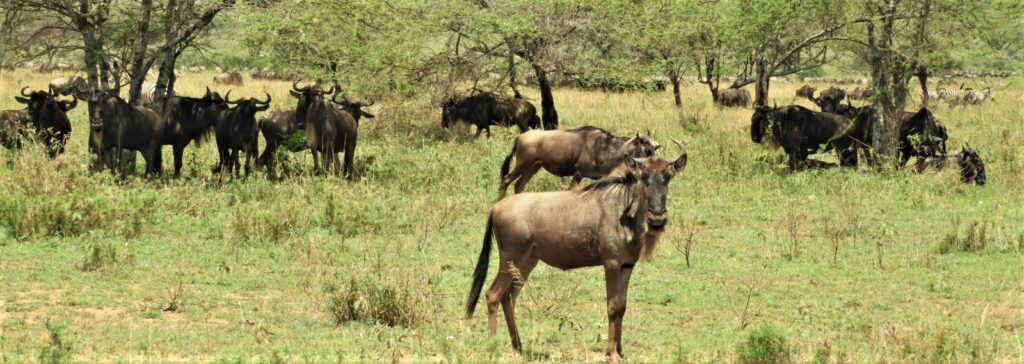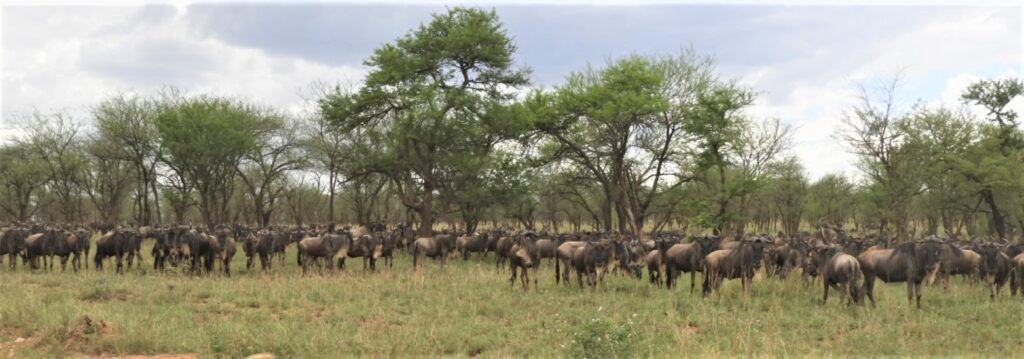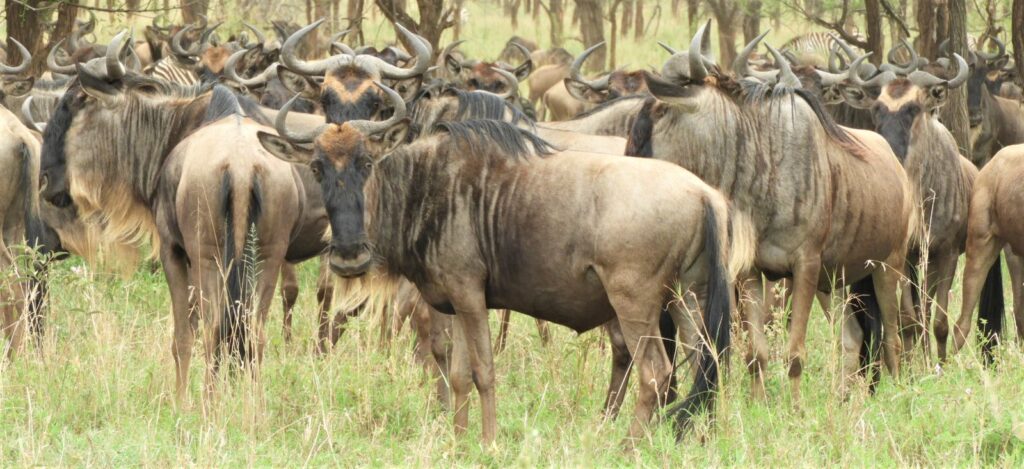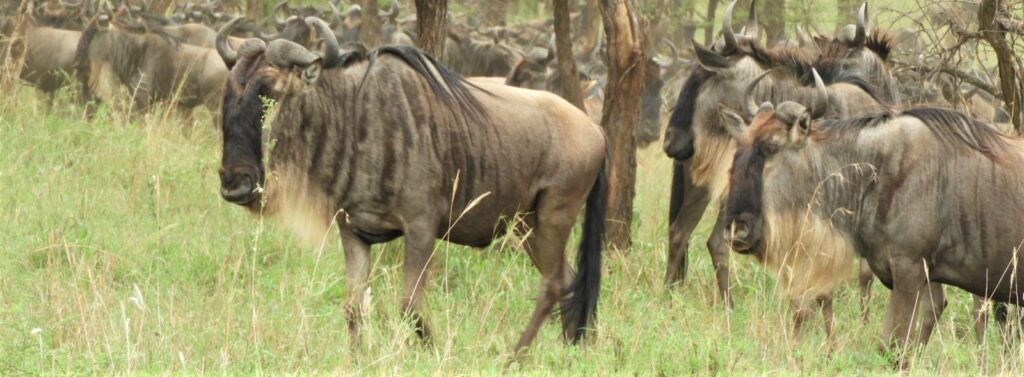» posted on Thursday, September 22nd, 2022 by Linda Lou Burton
Animals, Yes
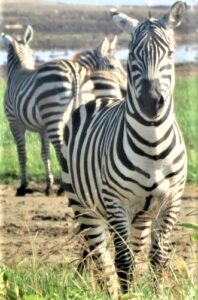 Linda Lou Burton posting from Mbuzi Mawe Serena Tented Camp, Serengeti National Park, Tanzania– Believe it or not! We actually spotted animals today once we really got going. Lots of them, in fact. Yes, we saw lions (sleeping). Yes, we saw hippos (sleeping). And boy oh boy did we see wildebeests (definitely NOT sleeping), the number of which surprised even our guide. The day began with pretty giraffes, closeup; giraffes have been on my Top 5 List since that day in Nairobi when I fed them, face to face. They are so graceful, and easy-going. Zebras are also on my Top 5. Have you noticed in photos – a zebra looks good from any angle. Their faces are nicely proportioned; turn them around and their rumps are too! Their tails cover what tails do not cover on baboons (ach!) and are nicely braided at the tip. And a side view of a zebra is pleasant to look at too; a nice black and white stripe;
Linda Lou Burton posting from Mbuzi Mawe Serena Tented Camp, Serengeti National Park, Tanzania– Believe it or not! We actually spotted animals today once we really got going. Lots of them, in fact. Yes, we saw lions (sleeping). Yes, we saw hippos (sleeping). And boy oh boy did we see wildebeests (definitely NOT sleeping), the number of which surprised even our guide. The day began with pretty giraffes, closeup; giraffes have been on my Top 5 List since that day in Nairobi when I fed them, face to face. They are so graceful, and easy-going. Zebras are also on my Top 5. Have you noticed in photos – a zebra looks good from any angle. Their faces are nicely proportioned; turn them around and their rumps are too! Their tails cover what tails do not cover on baboons (ach!) and are nicely braided at the tip. And a side view of a zebra is pleasant to look at too; a nice black and white stripe; 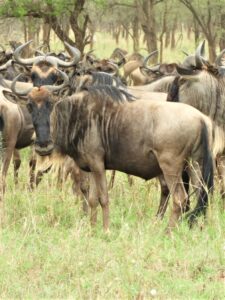 they’re always neatly dressed and easy to spot in a crowd. Now, here is your Animal Question of the Day: WHY, as we observed clearly this afternoon, do zebras and wildebeests hang out together? Wildebeests, aka gnus, are of the antelope family (I learned today) and though they may be good partners with zebras, share no resemblance whatsoever. Their manes and tails are dark and shaggy; they have broad muzzles, Roman noses, and curving horns. What makes them such good partners, especially during migration times?
they’re always neatly dressed and easy to spot in a crowd. Now, here is your Animal Question of the Day: WHY, as we observed clearly this afternoon, do zebras and wildebeests hang out together? Wildebeests, aka gnus, are of the antelope family (I learned today) and though they may be good partners with zebras, share no resemblance whatsoever. Their manes and tails are dark and shaggy; they have broad muzzles, Roman noses, and curving horns. What makes them such good partners, especially during migration times?
One simple reason, as they both go hunting for fresh grasslands: zebras love the taller grasses; wildebeest prefer short grasses. Like Jack Sprat and his wife, they are perfect partners when it comes to dinnertime. But there’s more: zebras have great eyesight and wildebeests have a good sense of smell. All helpful to each other for predator alerts (zebra eyesight) and finding water (wildebeest smell). Wildebeests also have “swarm intelligence” which means they are good at solving problems as a group. It was a thrill to watch this partnership in action today! The pictures below are NOT of the same wildebeests over and over; many were moving, over the period of an hour; watch for zebras in the crowd. Wow! as some might say. The sleeping lion was just as we entered the Park; the sleeping hippos were before we reached the wildebeests; the last animal I saw in this busy animal day was a hyrax, sleeping beside the porch of my tent. A hyrax looks much like a pika, or marmot, but guess what, boys and girls – it is more closely related to the elephant! And that is a story for the next post.
Serengeti National Park https://www.serengeti.com/
Mbuzi Mawe Serena Tented Camp https://www.serenahotels.com/mbuzi-mawe
Next Post: Tea and Slippers

